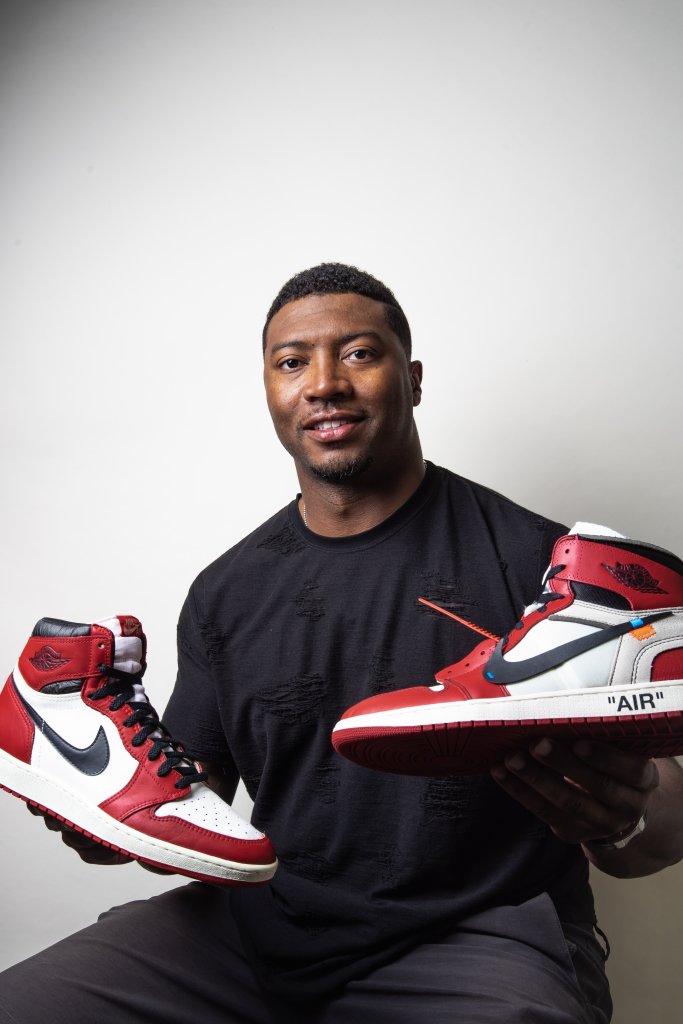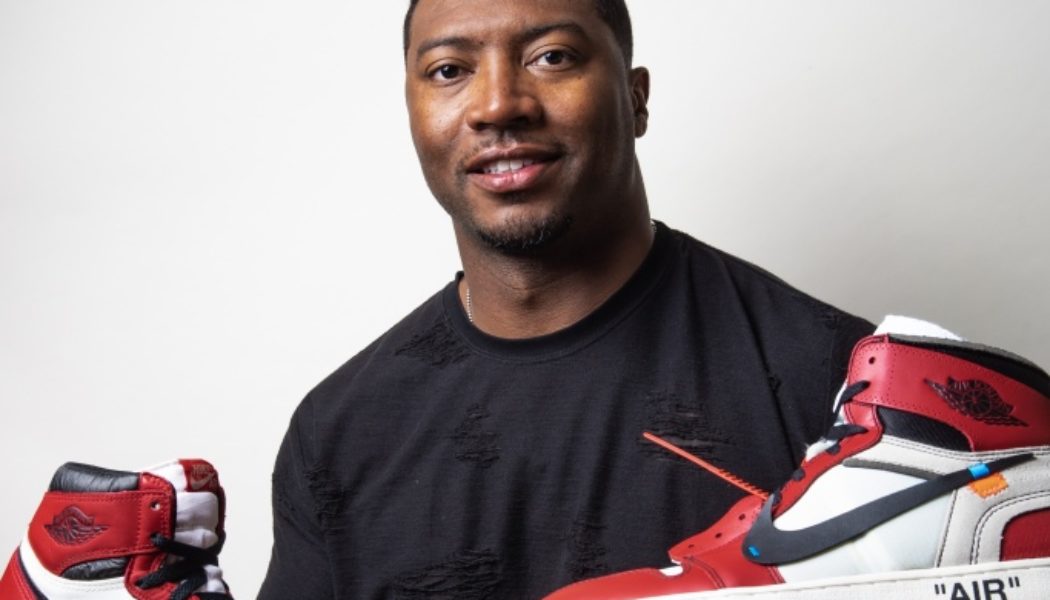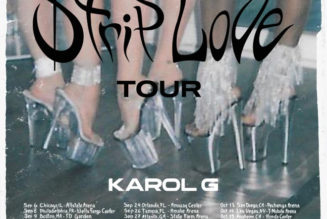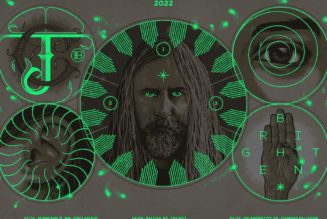
Source: handout / RARES
Sneakers are big money, and investing in them is a no-brainer, now. Gerome Sapp, a former NFL player and the Founder & CEO of RARES, introduced a new app that allows users to literally invest in kicks, but convincing venture capitalists of the money in the sneaker game was practically a non-starter.
Despite a degree in Finance from Notre Dame (and an MBA from Harvard Business School), a keen insight into the viability of sneakers as an asset class, and a dedication inherent in anyone who can carve out a career as a pro-athlete, Sapp had to pull up stakes and go for self.
“Finally, I was just like, ‘these people aren’t even my demographic’,” recalls Sapp of getting the cold shoulder from venture capitalists. “They don’t understand sneakers. They can’t think outside the proverbial sneaker box. So, I’m chasing ghosts here. [It was] one of the hardest things I’ve ever had to do is stop pitching it and save my money up for essentially three years.”
After a few years of putting aside his own dough, Sapp was able to launch RARES, a sneaker investment app. The company received a strategic jolt of marketing gold (note: sneakers currently trade higher than the aforementioned precious ore) when it was revealed that it was Sapp and RARES that brought the Air Yeezy Prototypes that sold at auction for $1.8 million.
Hip-Hop Wired spoke to Sapp for our The Sneaker Game column about what it took to bring RARES to market and the inspiring conversation including topics like representing for people of color in the Tech space, never giving up after hearing no repeatedly and the inspiration found in the freshest of sneakers.
“I went out pitching this idea to investors around four years ago, and I was told no 87 times. I thought they were crazy for saying no—that never wavered my confidence in the concept or the industry.”
HipHopWIred: Let’s get right to it, you were a high school football star, went to Notre Dame, and eventually the NFL. But, when did you first get into sneakers?
Gerome Sapp: I first got into sneakers when my father gave me a pair of Jordan 4s before he went into prison. That got me hooked on Jordan 4’s. With Jordan’s in general, I always had a sentimental value to me because of that, right? After that, we couldn’t afford Jordan’s anymore. I was probably about eight or nine [years old. I always looked at Jordan as not only the man, but the shoe is an inspiration. Almost like if Michael Jordan, a Black guy, that was once a Black kid like me, could get an endorsement deal from Nike to get his own shoe, so, can I. Not that I want my own shoe, but it was almost like the possibilities are endless. And this shoe represented that type of success or potential of success and I think that’s where my love for sneakers really started.
HHW: You were a football star so we figure you were able to get blessed with some better kicks than usual, right?
Sapp: When I got to high school I started being able to wear nicer kicks because I was actually working, and I can afford it. Nothing too crazy. But I was a Jordan guy. I remember the 11s came out. It was a wrap after that, You know what I’m saying? And then I got a scholarship to Notre Dame. And the crazy thing is, in South Bend, Ind., nobody gave a damn about sneakers. But I did, though. I still wore my kicks up there.
HHW: Was it still a Nike school at that time?
Sapp: Actually, it was in Adidas school. So, my shoe game was kind of more like on my own time. An offseason type thing. But in the meantime, I was studying finance. I was a finance major, and then in the summertime, I would work at Merrill Lynch back in Houston. I’d go home for about a month and a half and get an internship. I was learning money management from a real-world perspective.
HHW: So that sparked the business interest?
Sapp: That’s why I started to craft kind of this idea. I wanted to do something in finance, but something that was out of the box. I didn’t want to sit behind a desk, but I was fortunate enough to get drafted. I really started to buy a lot of sneakers at that point. But then in the off-season, I went to Harvard Business School, and that’s really where the concept of RARES was born. I remember actually wearing some Jordan 11s and the dude stepped on my sneakers, and I remember checking him. I was like, “Well, he didn’t step on the laces, right?” I remember getting to class wiping my sneaker off and thinking, “Man, there’s got to be a better way to get value out of this sneaker because I knew at that point, sneakers were appreciating.” This was before the secondary market and corporate America really started taking note, it was about 2005 or 2006…
HHW: Before spots like Flight Club and Stadium Goods really spotlighted the money that could be made.
Sapp: This is well before that and in my business class, I started to learn about alternative assets. When the professor talked about an alternative asset, my mind instantly shot to sneakers because I knew it as an asset class all of its own — this is still at Harvard. And obviously, it was an alternative, too. It wasn’t something that you can readily invest in on the stock market. I was like, “Man, what if you can turn this sneaker into stocks, or, more importantly, turn it into the equivalent of a company and allow people to invest in this company?” Essentially, you securitized the shoes, split them into shares, and allow people to own shares in the shoe if they can’t [own flat out] because, at that point, a lot of people started to get priced out of the sneaker game, especially the communities and cultures that I came from that made the sneaker game what it is that made it valuable and made it popular somewhere along the line. More importantly, they were being priced out of the secondary appreciation of the shoes.
HHW: Right, you can cover the shoe but there’s no way it makes it into your own collection if you don’t have the income.
SAPP: What if you split a shoe up into thousands of shares and allow people to own shares in it? So, when that shoe would appreciate in value, so do the shares you own in that sneaker. Just like in a company. When a company appreciates in value, if you’re a stockholder in that company, you reap the benefit, too, via your stocks. So, I was like, “Man, what if you do that with the sneaker?” But at the time, it was a little ahead of [its] time, way ahead of time. It was just an idea. I ended up playing a few more years in the NFL, starting a few tech companies. That’s why I’m actually out here in [Las] Vegas because my lead investor, Tony Shai, was out here and he’s like, “If you want this money, you got to move to Vegas.”
So, I relocated the family to Vegas and ended up selling out of that company. But the concept of securitizing sneakers [was] still on my mind. Basically, when StockX came out, I remember thinking, this is an opportunity to do what I always wanted to do, because for the first time, companies like StockX and GOAT, they centralized the pricing around sneakers. The evaluation of a sneaker, basically meaning you can go to one place and for the most part, people agree that this is the price that this sneaker is worth. Once you centralize the pricing or have a centralized pricing mechanism, you can create a market around that, like a real market.
About that time, [President Obama] was leaving office. He changed the rules and regulations around Regulation A to allow people, unaccredited investors, to start making investments in real securities. Before that, you couldn’t do that. Basically, he wanted to pump money into the economy via investment.
HHW: So before Obama made that move, it was “illegal”?
Sapp: Exactly. Before then, there was no law or regulation that would allow for that. But when Obama’s administration made that change to Regulation A, which is a part of the Jobs Act, opening the door for fractionalized ownership and allowing people, especially people who don’t make a certain amount of money a year, to invest a portion of their income into these assets. So when I read that, I was like, “Oh, sh*t.”
I cold-called one SEC regulation attorney [I saw in] Forbes. I remember calling him, and he answered. I said to him, “Hey, I know you don’t know me. My name is Gerome Sapp, but we’re gonna be best friends in a year.” And he answers, “Well, who are you?” The funny thing is, he’s now our Regulation attorney. I pitched him that idea, and he said, “Man, this is brand new. No one’s thinking about fractional ownership and sneakers.” Rally Road was the only company around at that point, and they were factionalizing ownership in automobiles and collectibles. So, I knew it could be done for sneakers, and I knew sneakers were a more liquid asset class. There were millions of transactions being done a day online for sneakers. We’re just offering them another way to own a sneaker and make money off of it, which most people wanted to flip the sneaker just to make money anyway. Now we’re making it easy for them.
HHW: Sounds good on paper but were you able to convince investors immediately?
Sapp: I went out pitching this idea to investors around four years ago, and I was told no 87 times. I started keeping track of them in my journal. The crazy thing about the whole being told no that many times, I still thought they were crazy for saying no—that never wavered my confidence in the concept or the industry. I thought these 87 people are out of their damn minds for not understanding what I’m presenting to them. But also, I didn’t take it personally. And I think being an athlete helped me with that. You’re told “No, you’re not good enough or your body is not what it used to be. We’re going to go younger and we’re going to cut you.” You learn how to [not] take those things personally. That’s part of the business. That really helped me when I was out there, literally pounding the concrete, going from VC to VC, pitching this idea, pitching my heart out. And when they said no, I wanted to understand why they said no. Then I took notes on that because maybe I could improve my pitch. That’s when it started to be a game to me of how I can improve my pitch to get a yes.
HHW: What were some of the reasons that these VCs are telling you that we’re not going to give you any money? What were some of the rationale for it sounds like, in hindsight, obviously, it’s a great idea? But what… what are they not seeing?
Sapp: The biggest one was we don’t see collectible sneakers being big enough. It’s almost like how many collectible sneakers are there in the world. It’s like [a] f*cking million. You know what I’m saying? I mean, sorry to curse, but I’m like, there are millions of them. More importantly, Nike comes out with a new hype drop every week. What do you mean? I understood the situation. This is not my demographic. These aren’t sneaker people. They don’t know what I’m talking about. They have no point of reference to anything I’m saying.
HHW: Right.
Sapp: The other reasons were like, they didn’t know how this alternative asset space was going to go. We’ll keep in contact, or once another player comes in, the investment game, come back to us. And it’s almost like, Well, sh*t then I’m too late. But the biggest one is they just couldn’t see sneakers as an asset class that could support itself. So, I literally saved my money. I saved up for three years. That was hard because I remember praying, like “God, why do you keep this on my mind if I can’t do it yet?” It’s almost torture, you know what I’m saying? That’s when I saved up enough money and I was able to do it, I realized that’s why he kept it on my mind because he wanted me to be fresh with it. Even though I couldn’t do it. During that time, I still stayed up on all the relevant sneaker news and tech. So, when I was ready to do it, I had the money. I literally rolled right into it.
I made a phone call to one of my best friends who’s now my Chief Operating Officer and said, “Hey, remember that sneaker concept I was telling you about? Let’s do it.” This is the middle of the pandemic shutdown. So, we’re all sitting at home with nothing to do. And I was like, “This is now or never, the world literally slowed down to a halt.”
This is my chance to do what I’ve been thinking about for all these years, that’s how it started, literally. That’s how we got going. From there, the deeper reason was financial literacy and creating a marketplace for everyone, but especially us, the communities and cultures that I come from to have a chance to make money off an asset class that they already know about…people invest in what they know.
If you give them the opportunity to invest in something like a sneaker and make money, creating a new way to generate revenue out of an old kind of trend, something you’re familiar with. I thought that that would be very special and beneficial to everyone, but especially the Black community, minority communities. That’s essentially what we’re doing. We’re creating a new way to generate wealth or revenue by allowing people to invest in what they know. Even if you don’t know about how sneakers appreciate or the factors that go into it, you have a certain familiarity with sneakers from your childhood. So, we’re asking you now to come to the side and let me educate you a little more. That’s not necessarily a big ask, especially when that’s potentially money to be made on the other side of that. Essentially, that’s the why behind RARES.
HHW: the RARES app has a section that explains the procedure in layman terms. Basically, that could easily be applied to the stock market where a lot of people might be intimidated or think that there’s no way into that. This could be that entry.
Sapp: You hit it on the head. This is like the gateway into bigger investments for a lot of people. This is the first time some have invested in any type of security. It just so happens to be a sneaker. We figured out a way to turn a sneaker into a security. By making it digestible and, let’s be honest, tangible, we attract more people and we appeal to more people because we’re not trying to talk over your head. We’re trying to talk to you and educate you and allow you to make money off of it. That’s exactly what we set out to do. Let’s explain this simply as possible, and we’ll educate you and help you become a better investor, starting with sneakers. Eventually, you’ll move on to other things and increase your portfolio. But why not start with sneakers?
HHW: How are things going now? Like how many users do you have, what are your projections, and the like?
Sapp: We have about 30,000 users now and of that, we have about 5000 we call active users that are literally investing in every IPO we drop. But we’re in the process of raising an investment round, so we know once we close that round, we’ll do a bunch more marketing, and eventually, RARES will become a household name. We’re in conversation with Cash App to do a partnership with them, we’re in conversation with Foot Locker, [we have] a lot of big opportunities ahead of us. I think we’re in the right place at the right time.
HHW: So, you famously purchased the Air Yeezy 1 prototypes that Kanye West wore at auction. How did that actually happen?
Sapp: I’ll tell you a back story. I don’t think I’ve ever told this story before. Sotheby’s reached out to me maybe five months before. More specifically, Brahm Wachter at Sotheby’s, who’s the president of the sneaker and streetwear division. He reached out to me and was just like, “Hey, I heard you guys were launching, and you guys seem to be different.”
HHW: You’re definitely doing something right if Sotheby’s is hitting you up because they heard about you.
Sapp: Yeah, that was a real blessing. To be honest with you, we talked maybe once a month, just checking in. He called one morning and we were still in the Tech Stars accelerated program. Tech Stars is one of the top two accelerated programs in the world. They actually reached out to us to have us in the program and the funny thing is, they were hounding me about our go-to-market strategy, and I’m like, “Hey, man, don’t worry. We’ll have one.”
I remember leaving a virtual meeting with Tech Stars, and I got a call from the Sotheby’s brand. It went like, “Gerome, I got this sneaker. Let’s make a deal.” And there were other bidders, but Sotheby’s was like, “Listen, this shoe is perfect for you guys. I know it’s perfect. It’s perfect for everything you wanted to do.” Little did he know that shoe had a sentimental value to me. The Yeezy One prototype, I remember it because I retired from the NFL in 2008, and I remember watching that Grammy performance. Kanye wore the sneakers in 2008.
Let me rewind a little bit. All athletes go through some sort of identity purgatory when they retire. You play that sport your whole life. Anyone who’s done something their whole life and being good at it— their identity is wrapped in that to a degree. Then you don’t do it anymore, and you ask yourself,”Now, who am I?” I remember going through that a little bit and seeing Kanye wear these sneakers. I knew everything about these sneakers. It was a big deal because this is the first time Nike collaborated with a musician instead of an athlete and allowed the person to have input in the design. This shoe was a first for a lot of different things. I remember thinking, “Man, this shoe was going to propel Kanye, into a new height that I don’t even think he understands yet, because now he’s dabbling in sneakers and fashion.” That that literally hit me. It was like, okay, yeah, I could be an entrepreneur and have a better career as an entrepreneur than I did as an athlete. That’s what that shoe meant to me. That symbolized that to me.
So, fast forward, Graham is calling me to want to make a deal to purchase this shoe. It has sentimental value to me. But on the business side, that shoe is the grail of the sneaker industry, at least one of the five top grails. So, we had to make a deal from a business perspective. But from a personal perspective, obviously, I won’t let the personal stuff get in the way of business. I was satisfied once we made the deal because that let me know I was on the right track. Everything was happening in the way it needed to. We negotiated for two days and came to a price. The hardest part was holding it in and not really breaking the news that we arranged the deal to purchase that shoe. So, Tech Stars were still hounding me about our go-to-market strategy [but] once we broke that news, it was a game-changer for the company, for sure.
HHW: These rooms you’re in now often don’t have a lot of people that look like us. You mentioned it a little bit, but how important is it that you’re representing?
SAPP: It’s super important. I come in there and I know there’s an elephant in the room. A lot of people wanted to talk football with me as if I was there for football. And obviously, I mean, I get it. It’s a natural thing to want to talk to an ex-NFL athlete about football, but I always make sure that I curve the conversation back to my business and make sure that I was here for business and not to relive old war stories.
One thing they can’t take away from you is your mind. You show them your mind is sharp and you know what you’re talking about. I don’t care what they think about you, when you leave, you left a lasting impression on them That was my goal. It was super important to represent as well because we’re so underrepresented in the tech space, especially the finance tech space. Not only that, once we get investment, we don’t get reinvestment as much as our white counterparts. So not only do we have to be better, but we have to be consistently better. Once again, as an athlete, that was my life, man, always competing, always having to be better than the next man. And I understood if I wasn’t [there would be] consequences to that. So now I go to the tech space. That’s no different for me. I treat tech and I treat RARES in the same way I did with sports. In fact, that’s my therapy of not having that contact, that competition of football. The business world filled that for me. It’s competing in the business world, getting up in the morning, going over my notes, going over my schedule, being prepared that’s filled that void that sports created for me. So, I take this seriously.




![HHW Gaming: “Everything Is Game” In ‘NBA 2K21’s New Gameplay Trailer [Video]](https://www.wazupnaija.com/wp-content/uploads/2020/08/hhw-gaming-everything-is-game-in-nba-2k21s-new-gameplay-trailer-video-327x219.png)






